Abstract
The Betwa River basin, a semi-arid catchment that has been classified as a major hotspot of groundwater depletion in Central India. The rainfall and streamflow intermittency have affected agricultural practices due to the variability of groundwater availability for irrigation. This study evaluates the spatial and temporal variations of groundwater level (GWL) in the last 25 years (1993–2018) in the catchment. We applied a nonparametric Seasonal Trend decomposition based on the Loess (STL) method to decompose the GWL time series into the seasonal, trend, and remainder components. We observed that the GWL in the northeastern regions of the basin has depleted about 3–5 mbgl in the last two decades. During the same period, the basin has experienced a reduction in the rainfall magnitude (2.07 mm/yr). We observed that the overexploitation of groundwater for irrigation and rainfall variability have greatly impacted the GWL condition in the study area. Further, if the groundwater extraction continues at present rates, the Betwa River basin may experience severe depletion in the future.
1. Introduction
Groundwater is a natural freshwater resource that directly or indirectly affects millions of people living in drought-prone regions. Over-extraction of groundwater for domestic, agricultural, and industrial purposes has resulted in immense stress and a rapid decline in the groundwater level (GWL). Groundwater depletion has been severe, particularly in the arid and semi-arid regions [1]. Consequently, ecological and socioeconomic developments in these regions have been severely impacted [2]. Several studies have been conducted to assess groundwater depletion in the current and future scenarios [1,3,4,5]. For example, over-exploitation of GWL in the Middle East [6], North-East Pakistan, North-West India [7,8,9], United States of America [10], and North-East China [11] is responsible for the major hotspot of groundwater depletion in the world. If such a situation persists for a prolonged period, it may lead to the irreversible loss of groundwater resources in many of these regions. Additionally, frequent hydrological drought events due to warming climates are expected to intensify groundwater depletion in future [12,13,14,15].
The rapid rate of urbanisation and population growth have put imminent pressure on groundwater resources to meet the water demand for industrial and domestic purposes [16]. After the “Green revolution” in the 1960s, India experienced a significant change in landuse/landcover and an increase in groundwater consumption for irrigation. The forests were cut down for infrastructural developments and agriculture production, which has greatly altered the landuse/landcover pattern [17]. The change in landuse/landcover is an essential driver of the regional climate and hydrology [18,19,20]. It directly impacts hydrological processes such as infiltration, groundwater recharge, and runoff [19]. In India, about 230 billion m3 of groundwater is extracted annually for irrigation [21,22]. Particularly, the northwestern states such as Punjab, Haryana, Rajasthan, and the northern state of Uttar Pradesh have formed as the major hotspot of groundwater depletion [7]. The precipitation intensity is strongly linked with groundwater recharge [23]. Rainfall contributes about 68% of India’s annual groundwater resources [24]. The remaining 32% of the groundwater resources supply through the river seepage return flow from irrigation, recharge from lakes, ponds, and other water conservation structures [25]. Further, uneven rainfall pattern makes the groundwater resources uncertain.
In central India, groundwater is a primary source of drinking water and supports more than 70–80% of the water demand for agriculture [26]. Groundwater resources are heavily dependent on the Indian summer monsoon (June–September), as 90% of the annual rainfall receives only during the monsoon season and 10% of the annual rainfall in the remaining seasons of the year. Groundwater resources in the northern region of central India become more vulnerable due to a deficit in monsoon rainfall [27]. In addition, the changes in GWL is controlled by the groundwater recharge due to rainfall and groundwater extraction [23,28]. In recent years, the declining trend of monsoon rainfall and landuse/landcover change have impacted the discharge of the Betwa River [29].
Previous studies on the Betwa River basin mainly focused on surface hydrological responses (i.e., rainfall, runoff, infiltration, evapotranspiration). They suggested that the basin has experienced decline in runoff (21%) and percolation (9%) after 2001 [29,30,31,32], and groundwater potential zone [28]. Palmate et al. (2017) and Kumar et al. (2021) [33,34] studied the effect of climate change on vegetation, landcover, and surface hydrological responses. To the best of our knowledge, no such studies have been conducted that aim to understand the spatiotemporal variability of groundwater dynamics and quantify the changes in GWL due to rainfall.
The Spatio-temporal variation in GWL time series can be assessed using several statistical methods, such as parametric, non-parametric, and linear regression analysis [35]. The GWL time series usually has strong seasonal variations, which makes it difficult to detect a non-linear pattern in a time series through parametric and linear regression [36,37]. The non-parametric trend analysis method, such as Seasonal Trend decomposition based on Loess (STL), can easily detect non-linear patterns in a time series [37,38]. The STL decomposition method has been successfully used for time series analysis of the hydrological (discharge and GWL) [36] and environmental data (water quality, ecology, atmospheric sciences) [39]. The STL method uses the locally weighted regression (LOESS) technique [38], which makes it robust and flexible. The STL method decomposes time series data into three components (i.e., seasonal, trend, and remainder components) using an additive or multiplicative approach based on its nature. In recent studies, the STL decomposition has been widely used for the GWL trend analysis [37,40,41,42].
We use GWL measurements and statistical methods to quantify the seasonal variability of GWL in the Betwa River basin during the pre-and post-monsoon seasons from 1993 to 2018. We apply STL decomposition to evaluate the GWL trend to understand the long-term groundwater situation in the basin. Further, we explore the GWL fluctuations due to the change in landuse/landcover and rainfall.
2. Study Area
The Betwa River basin is located in Central India (Figure 1). It covers a total area of about 44,000 km2. It has nine districts (i.e., Ashoknagar, Bhopal, Chhatarpur, Lalitpur, Raisen, Sagar, Shivpuri, Sehore, and Vidisha) of Madhya Pradesh and five districts (i.e., Tikamgarh, Jhansi, Mahoba, and Hamirpur) of Uttar Pradesh. The Betwa River originates from the Raisen district of Madhya Pradesh and joins the Yamuna River near Hamirpur in Uttar Pradesh. The elevation in the catchment ranges from 76–715 m from the mean sea level (MSL). The basin’s southern region is relatively highly elevated (715–500 m) compared to the northeastern part. The elevation gradient starts to decline as the Betwa River starts to flow from South-West to North-East direction. For ease of understanding, the Betwa basin is also divided into three basins the upper (Sehore, Bhopal, Raisen, and Vidisha districts), lower (Tikamgarh, Chhatarpur, Jhansi, Hamirpur, Mahoba, and Jalaun districts), and middle basin (Ashoknagar, Sangar, Shivpuri, and Lalitpur districts) (Figure 1).
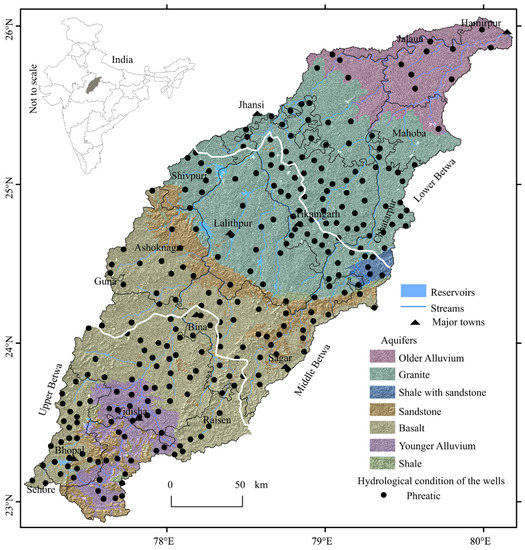
Figure 1.
Lithology map of the Betwa River basin is superimposed on a topographic map. Polygons in solid black is to show the district administrative boundary. Points in black represent the location of wells where the GWL data is monitored. The solid line in blue represents the drainage network.
The average annual rainfall in the basin varies from 700 to 1200 mm. The average minimum (winter) and maximum (summer) temperatures are about 7 and 43 °C, respectively. Based on the Köppen–Geiger climate classification, the Betwa River basin can be categorised into two zones [43]. The lower and central part of the basin falls in the sub-tropical semi-arid climatic zone with hot temperate summers and dry winters (sub-humid). The upper part of the basin falls in the semi-arid tropical savanna climatic zone with dry tropical winters and wet or moist summers of semi-arid conditions [43].
The Betwa River basin has several shallow groundwater aquifer systems (i.e., phreatic, confined, semi-confined, and unconfined aquifers). Table 1 reports the details of the wells in different aquifers. The GWL in the Betwa River basin ranges from 0 to 30 m below the ground level (mbgl). The subsurface geology of the basin is composed of both consolidated (basalt, granite, sandstone, and shale) and unconsolidated (alluvium) material (Figure 1).

Table 1.
District-wise detailed groundwater condition and lithology of the study area (CGWB).
The southern region of the basin is covered with Deccan basalt. The shallower groundwater systems in the Deccan basalt consist of the weathered vesicular amygdaloidal and compact basalt. The sub-vertical sheet joints and regional fractures in both basalts allow surface water to recharge into the ground. The Bundelkhand region (Lalitpur, Shivpuri, Tikamgarh, Chhatarpur, and Jhansi districts) of the middle and lower basin is covered with crystalline formation (Bundelkhand gneiss complex). It comprises old metamorphic, granite, banded iron formations, gneisses, calc-silicate, and quartz reefs. These formations are compacted with negligible primary porosity but have good secondary porosity. The northern region of the basin is covered with the younger alluvium silt, and sand deposits have good porosity and permeability. According to GEC-2015 report, the specific yields of the aquifers found in the Deccan Basalts (2%), Banded gneiss complex (1.5%), younger alluvium (6%), older alluvium (16%), sandstone (3%), and shale aquifers (1.5%).
3. Materials and Methods
3.1. Data Sets
We obtained the well inventory data of the Betwa River basin from Madhya Pradesh Water Resource Board (MPWRD) and the Central Ground Water Board (CGWB) for the periods between 1983–2018 and 1996–2018, respectively. The GWL measurements were collected as depth to the water table below ground level in meters (mbgl). The dataset contains 583 dug wells GWL data distributed throughout the basin. Among these, only 276 dug wells contain a long-term record of the seasonal GWL for the pre-monsoon (March–May), post-monsoon (October–November), monsoon (June–September), and winter (December–February). We have used the GWL of these 276 wells for further analysis (Figure 1).
We obtained the daily rainfall data in a gridded format at 0.25° (27.5 km × 27.5 km) resolution for a period between 1980–2018 from the Indian Meteorological Department (https://www.imdpune.gov.in/ (accessed on 15 October 2021)). To assess the topographic variation in the study area, we have used 1 × 1 arc-sec (30 m × 30 m) resolution Digital Elevation Model (DEM) of the Shuttle Radar Topography Mission (SRTM). We obtained the geological map of the basin from the Geological Survey of India (GSI) (https://bhukosh.gsi.gov.in/Bhukosh/Public (accessed on 11 August 2019)) at a 1:50,000 scale. Table 2 reports the detailed descriptions of the dataset.

Table 2.
List of the datasets (i.e., GWL, rainfall, lithological, and topographical satellite) used for the assessment of groundwater variability in this study. The table shows detailed description of the source, time period, data type, spatial, and temporal resolutions of the dataset.
3.2. Data Processing
The GWL datasets need to be pre-processed before we use them for further analysis. Our data archive has some wells with missing values, and some wells are recorded more frequently than others.
We have selected the well with minimum seasonal missing values (less than four, about 11%). We applied four different algorithms (i.e., AKIMA Spline, Spline, Linear Interpolation, and Kalman Filter) to fill the missing values in the time series. We evaluate the performances of these algorithms by estimating the missing GWL at a known period and computing their Root Mean Square Error (RMSE). We observed that the Kalman filter has the least RMSE values. We have used the Kalman filter to fill the gaps in the GWL time series data.
3.3. GWL Data Analysis
We have used an individual year’s GWL data (i.e., 1998, 2008, 2018) for pre- and post-monsoon seasons and performed the spatial analysis of GWL. The histograms of GWL for both periods are normally distributed (skewness ≈ 0 and kurtosis ≈ 3). These observations suggests that we can apply kriging interpolation to obtain the spatial distribution of GWL in the basin [44]. Geostatistical methods such as Ordinary Kriging (OK), Simple Kriging (SK), and Universal Kriging (UK) are widely used for spatial interpolation of the GWL, if the data is normally distributed [45,46]. To select an optimal kriging interpolation, we evaluate the OK, SK, and UK. Firstly, using the UK, we compared the widely used Circular, Spherical, Exponential, and Gaussian semivariogram models to predict the unknown GWL value at each location [47]. We noticed the Spherical semivariogram model performs better than the other three models. We have used the best fit Spherical semivariogram model for OK, SK, and UK interpolation techniques to prepare the spatial distributed GWL maps. We observed the Spherical semivariogram with OK gives the optimal interpolation results than SK and UK. Similar observations have been reported by Sinha et al. (2018), Kaur and Rishi (2018), and Machiwal et al. (2012) [24,48,49]. Therefore, we have used the OK interpolation technique and the Spherical semivariogram model to prepare the spatial distribution of GWL in the Betwa basin.
3.4. GWL Trend Analysis
We have performed trend analysis on the GWL data using a nonparametric STL method. The GWL time series usually has strong seasonal variations and is considered an additive in nature [36,40]. Hence, we used the STL method based on the additive approach to decompose the time series according to Equation (1).
is the GWL, is the trend, is seasonal, and is the residual components at time t.
This method extracts the seasonal, trend, and remainder components from a time series. It also helps to detect a long-term non-linear trend that cannot be accessed through the linear trend detection methods [37,38]. To decompose the GWL time series, we used moving ‘s’ and ‘t’ smoothing window parameters. The size of a moving window determines the extent to which decomposed components vary yearly [37]. The decomposed component values become relatively similar (straight line) as the window size increases. Alternatively, when the window length decreases, the value of the decomposed component will be similar to the local observed GWL (). We applied and compared the various smoothing windows at several wells and finally selected the optimal parameters (i.e., the trend smoothing window is 45, and the seasonal parameter window is 7) based on the trial-and-error method. The small window of seasonal parameters provides a considerable variation in the seasons of each year. The GWL trend of each well has been estimated using the stl() function using xts software package in R. The trend component of each well is further reduced into a single value by averaging the annual change in GWL trend; it can be expressed as , where is the total number of observations between 1993 and 2018. A detailed flow chart of the methodology is shown in Figure 2.
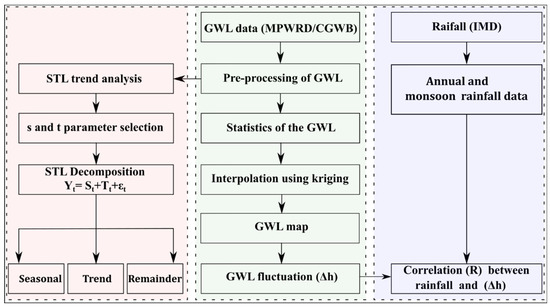
Figure 2.
Flow chart illustrates the detailed methodology of this study. The pre-processing of GWL data and estimation of GWL fluctuation are shown in the center box. The STL decomposition of GWL data is shown on the left box. The correlation between monsoon rainfall and GWL fluctuation is shown in the right box.
3.5. Correlation between Rainfall and GWL Fluctuation
We have used the Pearson correlation coefficient (R) to estimate the interrelationship between rainfall and GWL fluctuation. The expression of R is shown in Equation (2).
The variables and indicates monsoon rainfall and GWL fluctuations. Where the and are the mean monsoon rainfall and mean GWL fluctuation from 1997 to 2018, respectively.
4. Results
4.1. Validation of Semivariogram Model
We have predicted the spatial variability of GWL using the OK with Spherical semivariogram model. We prepared the spatial GWL maps for 1998, 2008, and 2018 and calculated the GWL change (∆h) to quantify their spatial and temporal variability. The Semivariogram of the GWL map is associated with three parameters (i.e., nugget, sill, and range). The nugget-to-sill ratio describes spatial dependence or autocorrelation. In our case, the nugget-to-sill ratio is 0.04; this indicates high autocorrelation. Figure 3 shows the best fit Spherical semivariogram model using the OK interpolation technique for the pre-monsoon GWL data of 2008.
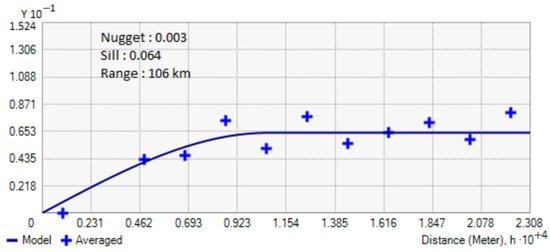
Figure 3.
The Spherical semivariogram model of the OK interpolation is fitted on the pre-monsoon GWL data of 2008.
4.2. Seasonal Variability of GWL
We prepared the spatial GWL maps for 1998, 2008, and 2018 to know the spatial distribution of the GWL during the pre-and post-monsoon periods (Figure 4a–f). We observed relatively deeper GWL (6–15 m) during the pre-monsoon in the study area (Figure 4a–c). The pre-monsoon GWL in the basin shows a decline in GWL after the 1998, except in the Lalitpur, Shivpuri, and Ashoknagar regions of the middle basin (Figure 4a–c). The GWL in the lower basin has depleted significantly from 7–8 to 13–15 mbgl) during the 1998–2008 per-monsoon period (Figure 4a–c). Overall, the GWL has depleted further in the 2008 and 2018 pre-monsoon periods, except in the Lalitpur district, where the GWL has remained at the same level (Figure 4e,f).
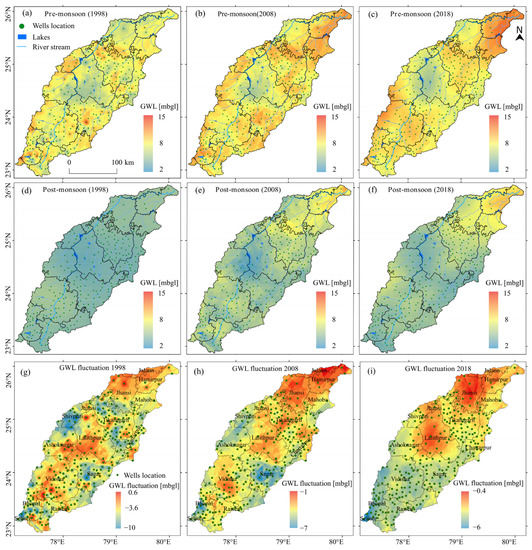
Figure 4.
The spatial distribution of the GWL images on the top represents the pre-monsoon period of 1998, 2008, and 2018 (a–c). Images in the middle represent GWL during the post-monsoon period 1998, 2008, and 2018 (d–f). The bottom three images show the annual groundwater change (fluctuation) from post-monsoon to pre-monsoon for 1998, 2008, and 2018 (g–i).
The post-monsoon GWL, throughout the catchment, is at a shallow depth (3–5) during 1998. It has depleted up to 5–7 mbgl in the upper (south), middle (central) and about 7–10 mbgl in the lower (northern) region of the basin until 2018 (Figure 4e,f).
We have estimated the GWL fluctuation from post-monsoon to pre-monsoon for 1998, 2008 and 2018, respectively (Figure 4g–i). The negative values indicate an increase in GWL fluctuation due to the rainfall period and vice-versa. The spatial map of GWL fluctuation shows that the middle and lower basin is continuously declining. Whereas the upper basin show increase in annual GWL fluctuation.
4.3. GWL Fluctuation
Figure 5 shows the GWL change in the last two decades, from 1998–2008 and 2008–2018, in the pre-and post-monsoon periods. During the pre-monsoon period of 1998–2008, a significant depletion (up to 3.7 m) is observed in the basin. Except for the Lalitpur, Shivpuri, and Ashoknagar districts, where the GWL has increased (1–2 m) during the same period (Figure 5a). From 2008 to 2018 pre-monsoon period, various region of the basin shows an increase (3–4 m) in the GWL. The GWL has depleted up to 3 mbgl in Vidisha, Hamirpur, Mahoba, Jalaun, and Tikamgarh districts (Figure 5b). In the post-monsoon period (1998–2008), the GWL has considerably changed throughout the basin (Figure 5c). For example, GWL in Lalitpur district shows about 1–2 mbgl rise. The northern (5–6 m) and southern (3–5 m) regions of the basins experienced a decline in post-monsoon GWL (Figure 5c). The spatial map of the GWL change during the post-monsoon from 2008–2018 shows the northern region of the basin has depleted by about 3–5 mbgl (Figure 5d).

Figure 5.
Spatial distribution of GWL change during the pre-monsoon period for 1998–2008 and 2008–2018 (a,b). The GWL change post-monsoon (bottom) periods (for 1998–2008 and 2008–2018) (c,d). The positive values (blue) indicate an increase, and the negative ones (red) show a decrease in GWL. The green dots show the wells used for interpolation of the GWL map for the respective periods. The solid black dots show wells used for the STL decomposition of GWL.
Overall, the GWL in the Betwa basin exhibits a declining trend in the last two decades, except for some districts in the central and western regions of the basin. The GWL depletion is more (3–5 m) in the lower basin as compared to the upper basin.
4.4. Observed Trend in GWL
We selected a well from the Bhopal district of the upper basin (BPL-080) and the Sagar district of the middle basin (SGR019) to assess the GWL trend using STL decomposition. These wells are situated in the Deccan basalt and have phreatic hydrological conditions (location of wells are shown in Figure 5c).
We estimated the STL parameters (‘s’- and ‘t’-window) based on the trial-and-error method. Then the decomposition parameters ‘s’-window and ‘t’-window are optimised as 7 and 45, respectively. Figure 6 shows the STL decomposition of the GWL time series data into seasonal, trend and remainder components. In Figure 6a, we have observed an increase in the variability of the seasonal and remainder components with time. In comparison, the trend component indicates decline in GWL (Figure 6a). The GWL is declining at a rate of 11 cm/yr from 1993 to 2002. During 2003–2005 and 2010–2013, the GWL trend remained constant. Further, the GWL declined at a rapid rate of 23 cm/yr for the remaining years in the time series (Figure 6a).
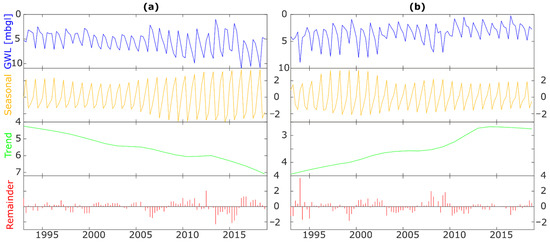
Figure 6.
STL decomposition of GWL (1993–2018) and their associated seasonal, trend, and remainder components are shown top to bottom, respectively. (a) Shows the STL decomposition of well number BPL-080. (b) Shows the STL decomposition of well number SGR019. Both of these wells are located in the Deccan basalt aquifer with phreatic hydrological conditions.
Figure 6b, we observe the trend component is moving towards the shallower depth at a rate of 7 cm/year from 1993 to 2013, but in recent years (2014–2018), the trend component shows a slight decrease in GWL (1 cm/yr). In contrast, to the trend component, both seasonal and remainder components have declined in time (Figure 6b).
4.5. The Relationship between GWL Fluctuation and Rainfall
The Pearson correlation coefficient (R) is estimated between the GWL fluctuation of wells and their grid-wise monsoon rainfall. Box plot of the R-values in the Deccan basalt, shale, granite banded gneiss complex, sandstone, younger and older alluvium aquifers shown in Figure 7. The R-values of each aquifer at median and between 25–75 percentiles show a distinct variation in the Betwa River basin. Shale with sandstone and granite aquifers shows a relatively high median R-value of 0.44 (n = 5) and 0.36 (n = 97), respectively. The median R-value of Basalt, younger, and older alluvium aquifers are observed as 0.22 (n = 121), 0.24 (n = 23), and 0.27 (n = 13), respectively, which show similar (low range) values and not significantly different from each other. The aquifers composed of sandstone have the lowest median R-value of 0.1 (n = 17). Their statistics are quite similar to the aquifers found in the basalt, granite, older, and younger alluvium, and considerably different aquifers in shale formations.

Figure 7.
The box plot of correlation coefficient (R) between groundwater fluctuation and monsoon rainfall (JJAS) of aquifers systems in the Betwa River basin. The extended dashed lines represent the minimum and maximum R-value ranges. The horizontal line in the box (solid black) represents the median value.
5. Discussion
The time series of the GWL of the Betwa basin shows a strong influence on seasonality. This seasonal variation is primarily controlled by the groundwater recharge due to rainfall [23] and groundwater extraction [28]. To assess this, we have compared the results of stl.fit() and standard stl() models. We obtained the lower remainder component using stl.fit() for the s-window (7) and t-window (45) parameters. Figure 8 compares these two models with the original GWL time series. The stl.fit() model fits better with the RMSE of 0.72 mbgl than the standard stl(), which has an RMSE of 0.73 mbgl.

Figure 8.
Time series of GWL from 1993 to 2018. The line in blue represents the observed GWL from the in situ data, and the lines in red and black are the fitted GWL using standard stl() auto and stl.fit() models, respectively.
In STL decomposition, the wells with a declining trend show an increase in seasonal and remainder component variability with time. These wells might have been influenced by anthropogenic activities (i.e., overexploitation of groundwater) and climate change. The STL trend analysis suggests that majority of wells in the Deccan basalt of the central and alluvium of the lower region of the Betwa basin have undergone a significant decline in the GWL from 5–25 cm/yr and more than 25 cm/yr, respectively (Figure 9). On the contrary to this, Shivpuri and Lalitpur districts do not show a significant depletion in the GWL. We observed that the wells near the streams show an increasing trend of up to 25 cm/yr of GWL (Figure 9). We also observed an increasing trend (5–25 cm/yr) for most of the wells in the upper basin’s younger alluvium and Deccan basalt aquifers. It coincides with the intermediate forest cover (33%) [50] and relatively high rainfall (1200 mm/yr) in the region (Figure 9). The intermediate forest cover and relatively high rainfall in the region might have increased groundwater recharge [51] through an increase in the infiltration of rainfall water into the ground [52], controlling the surface runoff [53], and eventually, the GWL [52].
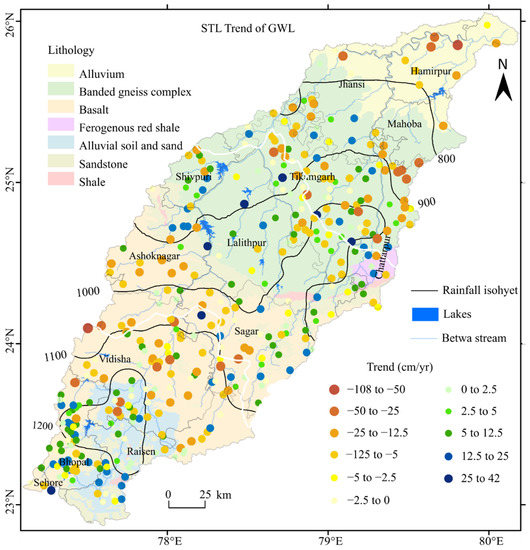
Figure 9.
Spatial distribution of the GWL trend component obtained from the STL decomposed. The lithology map is used in the background to understand the variability of the GWL trend in different lithology and geology types. Isohyetal lines in black illustrate the spatial distribution of mean annual rainfall in the study area.
Figure 9 shows that the GWL of all the wells in the northern region of the alluvium plain shows a declining GWL trend (<2.5 cm/yr). The alluvium aquifer system in this region has a relatively high porosity, permeability, and specific yield capacity of (16%) [54,55]. It is probably associated with relatively lower annual rainfall (<800 mm) and could be due to the overexploitation of groundwater for agricultural activities in the region [56,57,58,59]. We observed an increasing trend up to 25 cm/yr GWL in the younger alluvium aquifer located in the southern region of the basin. This region experiences annual precipitation (1200 mm) and has intermediate forest cover. Most of the wells found in the Bundelkhand granitic gneiss complex regions and Deccan basalt show a declining trend.
The aquifers of the central region of the Deccan basalt (Vidisha, Sagar, and Ashoknagar districts) and the Bundelkhand crystalline granitic gneiss complex (Tikamgarh, Jhansi, and Mahoba districts) have relatively less porosity, permeability, and specific yield. Most of the wells in these districts also have undergone a significant decline in GWL (5–25 cm/yr) in the past 25 years (1993–2018). In contrast, the GWL of the wells located in the Lalitpur and Shivpuri districts of the Bundelkhand crystalline aquifer show an increasing trend (Figure 9). This might be due to the presence of sub-surface dykes (secondary porosity) and major surface water bodies (Rajghat, Jamani, Rohini, Matatila Dam, and Gobind Sagar) in the regions that have eventually increased the annual recharge of GWL [60]. We observed most wells with an increasing GWL trend up to 25 cm/yr near the river channels (Figure 9). We suspect that recharge through streams and canals, and dams into the ground might have resulted in an increase in GWL near the channels.
The wells in the northern alluvium (Mahobba, Jhansi, and Hamirpur districts) aquifers show a declining trend in GWL with a rate of more than 25 cm/yr. The declining GWL trend in the alluvium aquifer might have resulted due to relatively less cumulative rainfall in the lower basin (<800 mm/yr).
5.1. Comparison between GWL Fluctuation and Rainfall
The Betwa basin receives about 90% of its rainfall during the monsoon period (JJAS months). The declining trend of rainfall [61,62] has resulted in a decline in the groundwater table [63,64]. To understand this, we performed the correlation analysis between GWL fluctuation and monsoon rainfall (Figure 10). The positive R-value indicates an increase in groundwater fluctuation with rainfall increment. There is a moderate positive (0.3–0.6 median R-value) linear relationship between the GWL fluctuation and monsoon rainfall in the wells located in Ashoknagar, Bhopal, Chhatarpur, Jhansi, Raisen, Hamirpur, and Tikamgarh districts. A weak (0–0.3 median R-value) linear relationship can be observed between the monsoon rainfall and the GWL fluctuation in the wells located in Lalitpur, Sagar, Sehore, Shivpuri, and Vidisha districts.
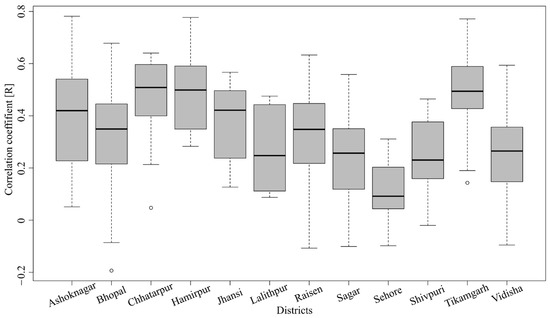
Figure 10.
District-wise correlation coefficient (R) between groundwater fluctuation and the monsoon rainfall. The extended dashed lines represent the minimum and maximum R-value ranges. The horizontal line in the box (solid black) represents the median value.
Wells with an R-value ≈ 0.8 in the Ashoknagar, Hamirpur, and Tikamgarh districts of the basin, indirectly indicate that extraction of GWL in the region has increased despite high recharge in GWL. We observed negative linear correlations of about 10% to 15% of the total wells located in the Bhopal, Raisen, Sehore, and Vidisha districts (Appendix A, Table A1 and Table A2). The negative effect indicates the wells might have experienced GWL depletion due to climate change and human perturbations.
Overall, the correlation analysis suggests that the monsoon rainfall moderately controls the GWL fluctuation in most of the wells. The moderate linear relationships between GWL and monsoon rainfall indicate that the recent variability in the monsoon rainfall could have affected the GWL.
5.2. Influence of Monsoonal Rainfall
We assess the GWL change in response to monsoon rainfall in the aquifers composed of different geological formations (basalt, granite, sandstone, shale with sandstone, younger alluvium, and older alluvium). The regression plots of annual average GWL fluctuation and monsoon rainfall in individual aquifers show a positive linear relationship (correlation coefficient between 0.41 to 0.77) (Figure 11a–f).
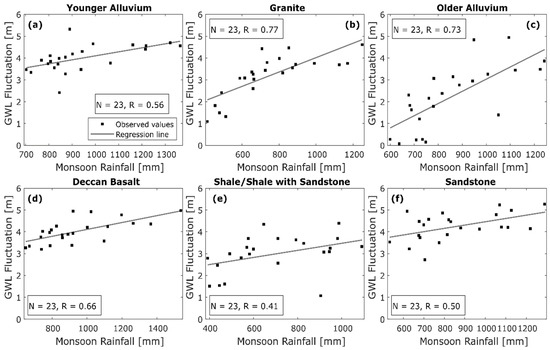
Figure 11.
Comparison of average GWL fluctuation and monsoon rainfall from 1996 to 2018 (n = 23) in the (a) Younger Alluvium, (b) Granite (banded gneiss complex), (c) Older Alluvium, (d) Deccan Basalt, (e) Shale/Shale with sandstone, (f) Sandstone aquifers, respectively.
Figure 11b shows a strong correlation coefficient (R = 0.77) in granite (banded gneiss complex) aquifers. Although the crystalline granite aquifer generally possesses low permeability and primary porosity, the GWL fluctuation has a high correlation coefficient (R = 0.77) with the monsoon rainfall. Granite in the middle and lower Betwa basin has good secondary porosity due to high lineament density, joints, fracturing, and weathering. The overburdened Bundelkhand granite is weathered from 5 to 30 mbgl and the fractures in granitic formation in this region allowed to form a deeper aquifer (up to 200 m depth) [65,66]. In the presence of secondary porosity in the crystalline hard rock of granite aquifer might have allowed quick change in GWL in response to rainfall. Brace et al. [67] found a similar observation that crystalline granite with joints and fractures has greater permeability than the matrix. Likewise, the fractures in the Bundelkhand granite may have allowed greater GWL fluctuation, hence the high correlation with rainfall.
The older alluvium aquifer in the lower basin shows the second-highest linkage (R-value of 0.73) between GWL fluctuation and monsoon rainfall (Figure 11c). The older alluvium aquifer in the Gangetic plain consists of a shallow unconfined system with a thickness greater than 150 m. The Gangetic alluvium aquifer has high porosity and permeability, which is highly suitable for groundwater recharge [68]. The older alluvium aquifer’s transmissivity and hydraulic conductivity range are 855–4107 m2/day, 48–93 m/day, and 10–800 μs/cm, respectively [69].
The younger alluvium aquifers in the upper basin show a moderate correlation coefficient (R-value of 0.55) with monsoon rainfall and GWL fluctuation (Figure 11a). The younger alluvium contains unconfined to the semi-confined aquifer, and its thickness ranges up to 40 m. The transmissivity and electric conductivity in younger alluvium aquifer vary from 100–3309 m2/day and 645 μs/cm [70]. The younger alluvium aquifer has a relatively low yield of 1095 m3/day than the older alluvium aquifer’s yield (6500 m3/day).
Overall, the hydrological properties of older alluvium show relatively high transmissivity, electric conductance, yield, and thickness values than younger alluvium. This suggests that the older alluvium aquifer responds better to rainfall; hence, the high correlation coefficient.
The Wells located in the Deccan basalt have a moderate correlation (R = 0.66) (Figure 11d). The deeper (80–300 m) aquifers in the Deccan basalt are multi-layered (intertrappean beds) with vesicular amygdaloidal joints, weathering, and fracturing system. The transmissivity and hydraulic conductivity in the Deccan basalt aquifer are 25–100 m2/day and 0.05–15 m/day [68]. In addition, secondary porosities allow the basalt aquifer to recharge easily.
In contrast, the aquifer in clay formation is characterised by low porosity and permeability (Figure 11e,f). Wells in the shale formation show minimum fluctuation (3–4 mbgl range) in GWL with similar frequency, duration, and magnitude of rainfall during the monsoon. The hydrological parameters of the shale aquifers show that the transmissivity and hydraulic conductivity varies within the range of 100–600 m2/day and 0–10 m/day, respectively. The shale aquifer exhibits the lowest GWL fluctuation response to rainfall due to low transmissivity and hydraulic conductivity.
Overall, the GWL fluctuation in the older alluvium, granite aquifers of high (primary or secondary) porosity and permeability are highly correlated to the rainfall. These aquifers are more suitable for groundwater recharge and may be used as a groundwater reservoir to meet the future groundwater demand.
5.3. Anthropogenic Impacts on Groundwater
The GWL change is estimated in the Betwa River basin between 1998 to 2018 for the post-monsoon period (Figure 12). The GWL decline is relatively severe in the lower basin, whereas the maximum decline in GWL is about 3 to 5.2 mbgl. In the middle Betwa River basin, GWL has declined from 2 to 3 mbgl. The GWL in the upper part of the basin has remained almost unchanged in the past two decades. Several studies have reported considerable change in the landuse/landcover in the basin [71,72,73,74]. The landuse/land cover change data are used from the recent studies on the Betwa River basin [33,33,72] to assess its associated impacts on the GWL. Forest cover and barren land have decreased in the study area. This has resulted in an increase in the agricultural land (1827 km2), waterbody (711 km2), and built-up area (84 km2) in the past two decades. Consequently, the hydrological processes (i.e., infiltration, runoff generation, and evapotranspiration) in the Betwa basin have been greatly altered [75].
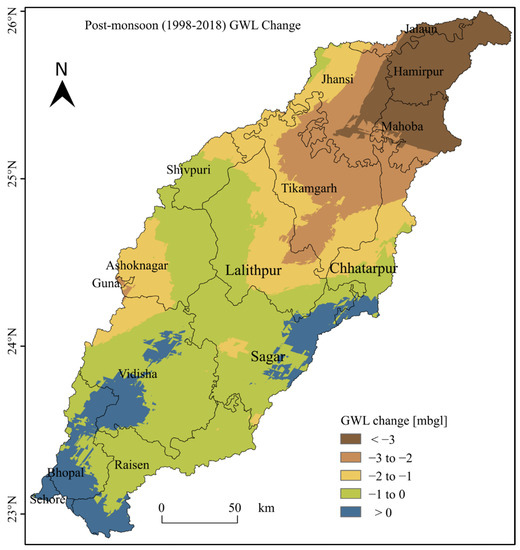
Figure 12.
The spatial distribution of GWL change during the post-monsoon period from 1998 to 2018. The polygons are the district administrative boundary.
In addition, an increase in population (38%) in the northern districts (Hamirpur, Jhansi, Jalaun, and Mahoba) in the last two decades (1991–2011) has led to an expansion of built-up and agricultural area by 0.2% and 4%, respectively, at the expense of forests (1.3%) and scrubland (25%) which might have impacted the GWL [31,74] (Figure 13a). The area with a GWL decline between 1–5.2 mbgl falls under the drought-prone region of Bundelkhand (Figure 9, Figure 12, and Figure 13a).
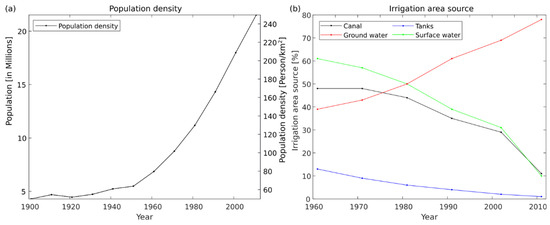
Figure 13.
(a) Census population data from 1901 to 2011 of the Betwa region districts. (b) Irrigation area in percentage from the canal, tanks, groundwater, and surface water sources (Source: MPKrishi.mp.gov.in (accessed on 20 June 2022)).
About 51% of the population growth in the Betwa basin from 1991 to 2011 has led to an increase in demand for food (Figure 13a). To achieve the food production demand, 4% of the agricultural land has increased in the study area. We suspect this might have resulted in GWL depletion. Several studies have shown, it has led to over-dependency on groundwater for irrigation purposes in Madhya Pradesh and quantified the irrigation area of different sources (i.e., canal, surface water, tube well, and tanks) [76]. Due to limited surface water resources, in the Betwa River basin, the irrigated area from the wells has significantly increased from 61% to 78%, whereas the contribution from the remaining sources has reduced to a minimal (Figure 13b).
For the past two decades, annual GWL fluctuation in the lower basin is continuously decreasing due to the exploitation of groundwater for irrigation purposes and the declining trend of rainfall in the region. It seems that the combined effect of over-exploitation of groundwater decline in rainfall has put the lower basin under immense pressure. Consequently, the GWL significantly decreased (>25 cm/yr) in the lower basin. Thus, it may lead to a quick formation of the hotspot which eventually affects the sustainable development in the region.
6. Conclusions
This study evaluated the spatial and temporal variation of the GWL and its association with monsoon rainfall in different aquifers of the Betwa river catchment. The spatial variability in the GWL data shows that the Betwa basin has experienced significant depletion. In particular, the lower and middle basins show a severe depletion in GWL magnitude and variability. The STL decomposition of the GWL data shows that the GWL trend component depleted significantly during the 1996–2018 period in the lower basin. The wells with a declining trend show an increase in seasonal and remainder component variability with time. However, these wells might have been influenced by groundwater over-exploitation and declining rainfall magnitude. Further, it is observed that the geology and soil properties strongly influence the GWL behavior regionally. For example, the GWL fluctuation in granite aquifer shows a high correlation with the monsoonal rainfall despite low porosity, permeability, transmissivity, and hydraulic conductivity, possibly due to secondary porosity (i.e., high lineament density and fractures). Whereas the older alluvium also shows a high correlation due to high transmissivity and hydraulic conductivity. On the other hand, the younger alluvium, basalt, sandstone, and shale aquifers exhibit a moderate correlation in response to the geohydrological condition of these aquifers. In addition to the declining rainfall trend, the population growth and over-exploitation of groundwater have resulted in the depletion of GWL due to consumptive use for irrigation and domestic purposes. This study can be extended further and may be used to model GWL variability under the projected climate and anthropogenic changes (i.e., over-exploitation, population growth) in Central Indian River basins. The finding of this study can be helpful for strategic planning, development, and management of groundwater resources in the semi-arid catchment.
Author Contributions
Conceptualization, M.N. and K.G.; methodology, M.N. and K.G.; software, M.N., K.G., A.K. and Z.B.; validation, M.N., K.G. and A.S.; formal analysis, M.N. and K.G.; investigation, K.G. and M.N.; resources, K.G.; data curation, A.K. and M.N.; writing—original draft preparation, M.N. and K.G.; writing—review and editing, K.G. and S.S.; visualization, M.N., A.S. and Z.B.; supervision, K.G.; project administration, K.G. All authors have read and agreed to the published version of the manuscript.
Funding
This research received no external funding.
Data Availability Statement
This study uses, openly available seasonal GWL data from Central Ground Water Board (CGWB) GWL, rainfall data from India Meteorological Department (IMD) (https://www.imdpune.gov.in/, accessed on 15 October 2021), lithology and aquifer information from Geological Survey of India (https://bhukosh.gsi.gov.in/Bhukosh/Public, accessed on 11 August 2019), and irrigation area source from MP Krishi (http://mpkrishi.mp.gov.in/, accessed on 15 October 2021).
Acknowledgments
The authors are grateful to the Central Ground Water Board (CGWB) and Madhya Pradesh Water Resources Department (MPWRD), Government of India, for providing the GWL data to conduct this study. We are also grateful to the Department of Earth and Environmental Science, Indian Institute of Science Education (IISER), Bhopal, for providing institutional support. We appreciate the editor’s input and that of the four anonymous reviewers for constructive comments and suggestions. The APC for this contribution is waived off.
Conflicts of Interest
On behalf of all authors, the corresponding author states that there are no conflict of interest.
Appendix A

Table A1.
The correlation coefficient (R) of GWL fluctuation in response to the monsoon rainfall.
Table A1.
The correlation coefficient (R) of GWL fluctuation in response to the monsoon rainfall.
| Region | No. of Wells | Average Rainfall [mm] | Strong Correlation | Moderate Correlation Wells [%] | Weak Correlation Wells [%] | ||
|---|---|---|---|---|---|---|---|
| Positive (R > 0.7) | Positive (0.3 < R < 0.7) | Negative (−0.7 < R < −0.3) | Positive (3 > R > 0) | Negative (0 > R > −0.3) | |||
| Bhopal | 23 | 1078 | 4 | 43 | 0 | 51 | 10 |
| Chattarpur | 27 | 1046 | 0 | 78 | 0 | 22 | 0 |
| Raisen | 18 | 1200 | 0 | 50 | 0 | 44 | 12 |
| Ashoknagar | 16 | 947 | 6 | 63 | 0 | 31 | 0 |
| Sehore | 9 | 1104 | 0 | 33 | 0 | 67 | 11 |
| Sagar | 46 | 1094 | 0 | 17 | 2 | 83 | 26 |
| Shivpuri | 10 | 860 | 0 | 10 | 0 | 70 | 20 |
| Tikamgarh | 57 | 904 | 2 | 67 | 0 | 32 | 4 |
| Vidisha | 43 | 1123 | 0 | 26 | 0 | 74 | 14 |
| Hamirpur | 5 | 753 | 20 | 60 | 0 | 20 | 0 |
| Jhansi | 10 | 778 | 0 | 50 | 1 | 50 | 0 |
| Lalitpur | 12 | 903 | 0 | 42 | 0 | 58 | 25 |
| Mahoba | 1 | 822 | 0 | 100 | 0 | 0 | 0 |

Table A2.
Hydrogeological parameters of the aquifer systems in the study area (source: CGWB report).
Table A2.
Hydrogeological parameters of the aquifer systems in the study area (source: CGWB report).
| Aquifer | Transmissivity [m2/Day] | Hydraulic Conductivity [m/Day] | Thickness [m] |
|---|---|---|---|
| Older alluvium | 250–4000 | 10–800 | >150 |
| Sandstone and Shale | 10–600 | 0.1–10 | 50–180 |
| Basalt | 25–100 | 0.05–15 | 45–300 |
| Granite | 10–500 | 0.1–10 | 120–200 |
| Younger alluvium | 100–3309 | 10–645 | Up to 40 |
References
- Aeschbach-Hertig, W.; Gleeson, T. Regional Strategies for the Accelerating Global Problem of Groundwater Depletion. Nat. Geosci. 2012, 5, 853–861. [Google Scholar] [CrossRef]
- Gleeson, T.; VanderSteen, J.; Sophocleous, M.A.; Taniguchi, M.; Alley, W.M.; Allen, D.M.; Zhou, Y. Groundwater Sustainability Strategies. Nat. Geosci. 2010, 3, 378–379. [Google Scholar] [CrossRef]
- Wada, Y.; Van Beek, L.P.H.; Van Kempen, C.M.; Reckman, J.W.T.M.; Vasak, S.; Bierkens, M.F.P. Global Depletion of Groundwater Resources. Geophys. Res. Lett. 2010, 37, 1–5. [Google Scholar] [CrossRef]
- Dalin, C.; Wada, Y.; Kastner, T.; Puma, M.J. Groundwater Depletion Embedded in International Food Trade. Nature 2017, 543, 700–704. [Google Scholar] [CrossRef] [PubMed]
- Shah, T.; Molden, D.; Sakthivadivel, R.; Seckler, D. Global Groundwater Situation: Opportunities and Challenges. Econ. Political Wkly. 2001, 36, 4142–4150. [Google Scholar]
- Voss, K.A.; Famiglietti, J.S.; Lo, M.; De Linage, C.; Rodell, M.; Swenson, S.C. Groundwater Depletion in the Middle East from GRACE with Implications for Transboundary Water Management in the Tigris-Euphrates-Western Iran Region. Water Resour. Res. 2013, 49, 904–914. [Google Scholar] [CrossRef]
- Rodell, M.; Velicogna, I.; Famiglietti, J.S. Satellite-Based Estimates of Groundwater Depletion in India. Nature 2009, 460, 999–1002. [Google Scholar] [CrossRef]
- Jain, M.; Fishman, R.; Mondal, P.; Galford, G.L.; Bhattarai, N.; Naeem, S.; Lall, U.; DeFries, R.S. Groundwater Depletion Will Reduce Cropping Intensity in India. Sci. Adv. 2021, 7, eabd2849. [Google Scholar] [CrossRef]
- Zaveri, E.; Grogan, D.S.; Fisher-Vanden, K.; Frolking, S.; Lammers, R.B.; Wrenn, D.H.; Prusevich, A.; Nicholas, R.E. Invisible Water, Visible Impact: Groundwater Use and Indian Agriculture under Climate Change. Environ. Res. Lett. 2016, 11, 084005. [Google Scholar] [CrossRef]
- Konikow, L.F.; Kendy, E. Groundwater Depletion: A Global Problem. Hydrogeol. J. 2005, 13, 317–320. [Google Scholar] [CrossRef]
- Feng, W.; Zhong, M.; Lemoine, J.M.; Biancale, R.; Hsu, H.T.; Xia, J. Evaluation of Groundwater Depletion in North China Using the Gravity Recovery and Climate Experiment (GRACE) Data and Ground-Based Measurements. Water Resour. Res. 2013, 49, 2110–2118. [Google Scholar] [CrossRef]
- Thomas, B.F.; Famiglietti, J.S. Identifying Climate-Induced Groundwater Depletion in GRACE Observations. Sci. Rep. 2019, 9, 474. [Google Scholar] [CrossRef] [PubMed]
- Swain, S.; Taloor, A.K.; Dhal, L.; Sahoo, S.; Al-Ansari, N. Impact of Climate Change on Groundwater Hydrology: A Comprehensive Review and Current Status of the Indian Hydrogeology. Appl. Water Sci. 2022, 12, 120. [Google Scholar] [CrossRef]
- Panwar, S.; Chakrapani, G.J. Climate Change and Its Influence on Groundwater Resources. Curr. Sci. 2013, 105, 37–46. [Google Scholar]
- Wu, W.-Y.; Lo, M.-H.; Wada, Y.; Famiglietti, J.S.; Reager, J.T.; Yeh, P.J.-F.; Ducharne, A.; Yang, Z.-L. Divergent Effects of Climate Change on Future Groundwater Availability in Key Mid-Latitude Aquifers. Nat. Commun. 2020, 11, 3710. [Google Scholar] [CrossRef] [PubMed]
- McGrane, S.J. Impacts of Urbanisation on Hydrological and Water Quality Dynamics, and Urban Water Management: A Review. Hydrol. Sci. J. 2016, 61, 2295–2311. [Google Scholar] [CrossRef]
- Joshi, P.K.; Kumar, M.; Midha, N.; Paliwal, A. Assessing Areas Deforested by Coal Mining Activities through Satellite Remote Sensing Images and GIS in Parts of Korba, Chattisgarh. J. Indian Soc. Remote Sens. 2006, 34, 415–421. [Google Scholar] [CrossRef]
- Hutjes, R.; Kabat, P.; Running, S.; Shuttleworth, W.; Field, C.; Bass, B.; da Silva Dias, M.; Avissar, R.; Becker, A.; Claussen, M.; et al. Biospheric Aspects of the Hydrological Cycle. J. Hydrol. 1998, 212, 1–21. [Google Scholar] [CrossRef]
- DeFries, R.; Eshleman, K.N. Land-Use Change and Hydrologic Processes: A Major Focus for the Future. Hydrol. Process. 2004, 18, 2183–2186. [Google Scholar] [CrossRef]
- Zhang, L.; Dawes, W.R.; Walker, G.R. Response of Mean Annual Evapotranspiration to Vegetation Changes at Catchment Scale. Water Resour. Res. 2001, 37, 701–708. [Google Scholar] [CrossRef]
- Shankar, P.; Kulkarni, H.; Krishnana, S. India’s Groundwater Challenge and the Way Forward. Econ. Political Wkly. 2011, 46, 37–45. [Google Scholar]
- Mishra, V.; Asoka, A.; Vatta, K.; Lall, U. Groundwater Depletion and Associated CO2 Emissions in India. Earth’s Future 2018, 6, 1672–1681. [Google Scholar] [CrossRef]
- Asoka, A.; Wada, Y.; Fishman, R.; Mishra, V. Strong Linkage Between Precipitation Intensity and Monsoon Season Groundwater Recharge in India. Geophys. Res. Lett. 2018, 45, 5536–5544. [Google Scholar] [CrossRef]
- Sinha, R.; Gupta, S.; Nepal, S. Groundwater Dynamics in North Bihar Plains. Curr. Sci. 2018, 114, 2482–2493. [Google Scholar] [CrossRef]
- Annual Report 2013–14; Central Ground Water Board Ministry of Water Resources, River Development and Ganga Rejuvention: Faridabad, India, 2015; pp. 1–74.
- Annual Report 2007–2008; Central Ground Water Board Ministry of Water Resources Government of India: Faridabad, India, 2007; pp. 1–260.
- Banerjee, C.; Kumar, D.N. Assessment of Surface Water Storage Trends for Increasing Groundwater Areas in India. J. Hydrol. 2018, 562, 780–788. [Google Scholar] [CrossRef]
- Jeet, P.; Singh, D.K.; Sarangi, A. Groundwater Potential in a Drought Prone Betwa River Basin, Bundelkhand. Indian J. Agric. Sci. 2019, 89, 1623–1627. [Google Scholar] [CrossRef]
- Pandey, R.P.; Mishra, S.K.; Singh, R.; Ramasastri, K.S. Streamflow Drought Severity Analysis of Betwa River System (India). Water Resour. Manag. 2008, 22, 1127–1141. [Google Scholar] [CrossRef]
- Kumar, A.; Singh, A.; Gaurav, K. Assessing the Synergic Effect of Land Use and Climate Change on the Upper Betwa River Catchment in Central India under Present, Past, and Future Climate Scenarios. Environ. Dev. Sustain. 2022, 1–22. [Google Scholar] [CrossRef]
- Suryavanshi, S.; Pandey, A.; Chaube, U.C. Hydrological Simulation of the Betwa River Basin (India) Using the SWAT Model. Hydrol. Sci. J. 2017, 62, 960–978. [Google Scholar] [CrossRef]
- Pandey, A.; Dayal, D.; Palmate, S.S.; Mishra, S.K.; Himanshu, S.K.; Pandey, R.P. Long-Term Historic Changes in Temperature and Potential Evapotranspiration over Betwa River Basin. In Climate Impacts on Water Resources in India; Springer: Berlin/Heidelberg, Germany, 2021; pp. 267–286. [Google Scholar]
- Palmate, S.S.; Pandey, A.; Kumar, D.; Pandey, R.P.; Mishra, S.K. Climate Change Impact on Forest Cover and Vegetation in Betwa Basin, India. Appl. Water Sci. 2017, 7, 103–114. [Google Scholar] [CrossRef]
- Kumar, A.; Gaurav, K. Assessing the Impact of Climate and Land-Use Change on the Hydrological Response of the Upper Betwa River Basin. In Proceedings of the EGU General Assembly Conference Abstracts, Vienna, Austria, 19–30 April 2021; p. EGU21-14062. [Google Scholar]
- Helsel, D.R.; Hirsch, R.M. Statistical Methods in Water Resources, 4th-A3 ed.; United States Geological Survey: Reston, VA, USA, 2002. [Google Scholar]
- Lu, M.; Rogiers, B.; Beerten, K.; Gedeon, M.; Huysmans, M. Exploring River–Aquifer Interactions and Hydrological System Response Using Baseflow Separation, Impulse Response Modeling, and Time Series Analysis in Three Temperate Lowland Catchments. Hydrol. Earth Syst. Sci. 2022, 26, 3629–3649. [Google Scholar] [CrossRef]
- Shamsudduha, M.; Chandler, R.E.; Taylor, R.G.; Ahmed, K.M. Recent Trends in Groundwater Levels in a Highly Seasonal Hydrological System: The Ganges-Brahmaputra-Meghna Delta. Hydrol. Earth Syst. Sci. 2009, 13, 2373–2385. [Google Scholar] [CrossRef]
- Cleveland, R.B.; Cleveland, W.S.; McRae, J.E.; Terpenning, I. STL: A Seasonal-Trend Decomposition Procedure Based on Loess. J. Off. Stat. 1990, 6, 3–73. [Google Scholar]
- Carslaw, D.C. On the Changing Seasonal Cycles and Trends of Ozone at Mace Head, Ireland. Atmos. Chem. Phys. 2005, 5, 3441–3450. [Google Scholar] [CrossRef]
- Lafare, A.E.A.; Peach, D.W.; Hughes, A.G. Use of Seasonal Trend Decomposition to Understand Groundwater Behaviour in the Permo-Triassic Sandstone Aquifer, Eden Valley, UK. Hydrogeol. J. 2016, 24, 141–158. [Google Scholar] [CrossRef]
- Sakizadeh, M.; Mohamed, M.M.A.; Klammler, H. Trend Analysis and Spatial Prediction of Groundwater Levels Using Time Series Forecasting and a Novel Spatio-Temporal Method. Water Resour. Manag. 2019, 33, 1425–1437. [Google Scholar] [CrossRef]
- Xia, J.; Wu, X.; Zhan, C.; Qiao, Y.; Hong, S.; Yang, P.; Zou, L. Evaluating the Dynamics of Groundwater Depletion for an Arid Land in the Tarim Basin, China. Water 2019, 11, 186. [Google Scholar] [CrossRef]
- Beck, H.E.; Zimmermann, N.E.; McVicar, T.R.; Vergopolan, N.; Berg, A.; Wood, E.F. Present and Future Köppen-Geiger Climate Classification Maps at 1-Km Resolution. Sci. Data 2018, 5, 1–12. [Google Scholar] [CrossRef]
- Yao, L.; Huo, Z.; Feng, S.; Mao, X.; Kang, S.; Chen, J.; Xu, J.; Steenhuis, T.S. Evaluation of Spatial Interpolation Methods for Groundwater Level in an Arid Inland Oasis, Northwest China. Environ. Earth Sci. 2014, 71, 1911–1924. [Google Scholar] [CrossRef]
- Ahmadi, S.H.; Sedghamiz, A. Geostatistical Analysis of Spatial and Temporal Variations of Groundwater Level. Environ. Monit. Assess. 2007, 129, 277–294. [Google Scholar] [CrossRef]
- Negreiros, J.; Painho, M.; Aguilar, F.; Aguilar, M. Geographical Information Systems Principles of Ordinary Kriging Interpolator. J. Appl. Sci. 2010, 10, 852–867. [Google Scholar] [CrossRef]
- Cay, T.; Uyan, M. Spatial and Temporal Groundwater Level Variation Geostatistical Modeling in the City of Konya, Turkey. Water Environ. Res. 2009, 81, 2460–2470. [Google Scholar] [CrossRef] [PubMed]
- Kaur, L.; Rishi, M.S. Integrated Geospatial, Geostatistical, and Remote-Sensing Approach to Estimate Groundwater Level in North-Western India. Environ. Earth Sci. 2018, 77, 786. [Google Scholar] [CrossRef]
- Machiwal, D.; Mishra, A.; Jha, M.K.; Sharma, A.; Sisodia, S.S. Modeling Short-Term Spatial and Temporal Variability of Groundwater Level Using Geostatistics and GIS. Nat. Resour. Res. 2012, 21, 117–136. [Google Scholar] [CrossRef]
- Roy, P.S.; Meiyappan, P.; Joshi, P.K.; Kale, M.P.; Srivastav, V.K.; Srivasatava, S.K.; Behera, M.D.; Roy, A.; Sharma, Y.; Ramachandran, R.M.; et al. Decadal Land Use and Land Cover Classifications across India, 1985, 1995, 2005; ORNL Distributed Active Archive Center (ORNL DAAC): Oak Ridge, TN, USA, 2016. [Google Scholar]
- Clark, B.; DeFries, R.; Krishnaswamy, J. India’s Commitments to Increase Tree and Forest Cover: Consequences for Water Supply and Agriculture Production within the Central Indian Highlands. Water 2021, 13, 959. [Google Scholar] [CrossRef]
- Chandler, K.R.; Stevens, C.J.; Binley, A.; Keith, A.M. Influence of Tree Species and Forest Land Use on Soil Hydraulic Conductivity and Implications for Surface Runoff Generation. Geoderma 2018, 310, 120–127. [Google Scholar] [CrossRef]
- Owuor, S.O.; Guzha, A.C.; Rufino, M.C.; Pelster, D.E.; Breuer, L. Groundwater Recharge Rates and Surface Runoff Response to Land Use and Land Cover Changes in Semi-Arid Environments. Ecol. Process. 2016, 5, 16. [Google Scholar] [CrossRef]
- Bonsor, H.C.; MacDonald, A.M.; Ahmed, K.M.; Burgess, W.G.; Basharat, M.; Calow, R.C.; Dixit, A.; Foster, S.S.D.; Gopal, K.; Lapworth, D.J.; et al. Hydrogeological Typologies of the Indo-Gangetic Basin Alluvial Aquifer, South Asia. Hydrogeol. J. 2017, 25, 1377–1406. [Google Scholar] [CrossRef]
- GEC-2015 Report of the Ground Water Resources Estimation Committee (GEC-2015); Ministry of Water Resources, River Development & Ganga Rejuvenation Government of India: New Delhi, India, 2017; pp. 1–137.
- Ahmed, A.; Deb, D.; Mondal, S. Assessment of Rainfall Variability and Its Impact on Groundnut Yield in Bundelkhand Region of India. Curr. Sci. 2019, 117, 794–803. [Google Scholar] [CrossRef]
- Chourasia, L.P.; Jhariya, D.C. Water Crisis in the Bundelkhand Region: An Observation. IOP Conf. Ser. Earth Environ. Sci. 2020, 597, 012024. [Google Scholar] [CrossRef]
- Patle, D.; Awasthi, M.K. Past Two Decadal Groundwater Level Study in Tikamgarh District of Bundelkhand. J. Geol. Soc. India 2019, 94, 416–418. [Google Scholar] [CrossRef]
- Tiwari, A.; Joshi, S.K.; Tripathi, S.K.; Saxena, R. Spatial Pattern of Groundwater Recharge in Jhansi District in the Bundelkhand Region, Central India. Environ. Dev. Sustain. 2021, 23, 18618–18630. [Google Scholar] [CrossRef]
- Annual Report 2006–2007; Central Ground Water Board (CGWB) Ministry of Water Resources Goverment of India: Faridabad, India, 2006; pp. 1–284.
- Singh, A.; Gaurav, K.; Meena, G.K.; Kumar, S. Estimation of Soil Moisture Applying Modified Dubois Model to Sentinel-1; A Regional Study from Central India. Remote Sens. 2020, 12, 2266. [Google Scholar] [CrossRef]
- Saharwardi, M.S.; Mahadeo, A.S.; Kumar, P. Understanding Drought Dynamics and Variability over Bundelkhand Region. J. Earth Syst. Sci. 2021, 130, 122. [Google Scholar] [CrossRef]
- Mohanavelu, A.; Kasiviswanathan, K.S.; Mohanasundaram, S.; Ilampooranan, I.; He, J.; Pingale, S.M.; Soundharajan, B.S.; Mohaideen, M.M.D. Trends and Non-Stationarity in Groundwater Level Changes in Rapidly Developing Indian Cities. Water 2020, 12, 3209. [Google Scholar] [CrossRef]
- Kumar, M.D.; Perry, C.J. What Can Explain Groundwater Rejuvenation in Gujarat in Recent Years? Int. J. Water Resour. Dev. 2019, 35, 891–906. [Google Scholar] [CrossRef]
- Thakur, G.S.; Usmani, H.U.; Gupta, S.K. Bhimkund and Arjunkund Dolines, Chhatarpur District, Madhya Pradesh. J. Geol. Soc. India 2010, 76, 369–370. [Google Scholar] [CrossRef]
- Aquifer Maps and Ground Water Management Plan of Jhansi District, Uttar Pradesh; Central Ground Water Board (CGWB) Ministry of Water Resources, River Development and Ganga Rejuvenation Government of India: Lucknow, India, 2017; pp. 1–62.
- Porosity, Permeability, and Their Relationship in Granite, Basalt, and Tuff; Intera Environmental Consultants, Inc.: Houston, TX, USA, 1983; pp. 1–87.
- Bhanja, S.N.; Mukherjee, A.; Rangarajan, R.; Scanlon, B.R.; Malakar, P.; Verma, S. Long-Term Groundwater Recharge Rates across India by in Situ Measurements. Hydrol. Earth Syst. Sci. 2019, 23, 711–722. [Google Scholar] [CrossRef]
- Mankikar, T.Y. Aquifer Mapping and Management of Groundwater Resources of Hamirpur District, Uttar Pradesh; Central Ground Water Board Department of Water Resources, River Development and Ganga Rejuvenation, Ministry of Jal Shakti Government of India: Lucknow, India, 2018; pp. 1–72. [Google Scholar]
- Aquifer Systems of Madhya Pradesh; Cental Ground Water Board (CGWB) Ministry of Water Resources: Bhopal, India, 2013; pp. 1–78.
- Singh, D.K.; Singh, A.K. Groundwater Situation in India: Problems and Perspective. Int. J. Water Resour. Dev. 2002, 18, 563–580. [Google Scholar] [CrossRef]
- Roy, P.S.; Roy, A.; Joshi, P.K.; Kale, M.P.; Srivastava, V.K.; Srivastava, S.K.; Dwevidi, R.S.; Joshi, C.; Behera, M.D.; Meiyappan, P.; et al. Development of Decadal (1985–1995–2005) Land Use and Land Cover Database for India. Remote Sens. 2015, 7, 2401–2430. [Google Scholar] [CrossRef]
- Palmate, S.S.; Wagner, P.D.; Fohrer, N.; Pandey, A. Assessment of Uncertainties in Modelling Land Use Change with an Integrated Cellular Automata–Markov Chain Model. Environ. Model. Assess. 2022, 27, 275–293. [Google Scholar] [CrossRef]
- Palmate, S.S.; Pandey, A.; Mishra, S.K. Modelling Spatiotemporal Land Dynamics for a Trans-Boundary River Basin Using Integrated Cellular Automata and Markov Chain Approach. Appl. Geogr. 2017, 82, 11–23. [Google Scholar] [CrossRef]
- Kumar, M.; Denis, D.M.; Kundu, A.; Joshi, N.; Suryavanshi, S. Understanding Land Use/Land Cover and Climate Change Impacts on Hydrological Components of Usri Watershed, India. Appl. Water Sci. 2022, 12, 39. [Google Scholar] [CrossRef]
- Vijay Shankar, P.S. Four Decades of Agricultural Development in MP: An Agro-Ecological Sub-Region Approach. Econ. Political Wkly. 2005, 40, 5014–5024. [Google Scholar]
Publisher’s Note: MDPI stays neutral with regard to jurisdictional claims in published maps and institutional affiliations. |
© 2022 by the authors. Licensee MDPI, Basel, Switzerland. This article is an open access article distributed under the terms and conditions of the Creative Commons Attribution (CC BY) license (https://creativecommons.org/licenses/by/4.0/).